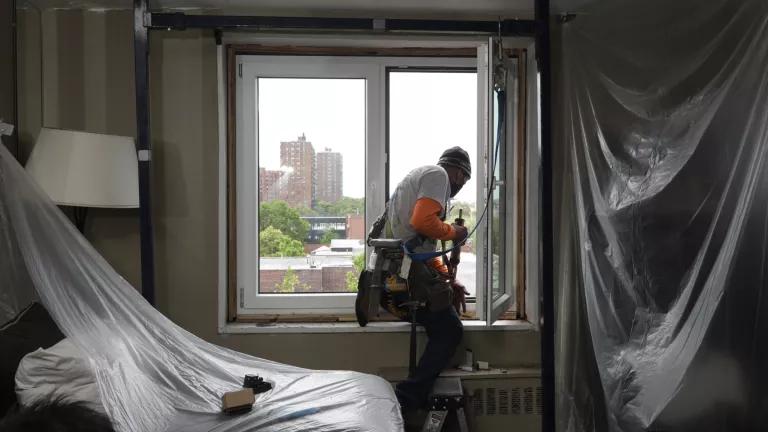San José Launches Energy Challenge to Cut Building Emissions

The City of San José is making a big step toward its greenhouse gas (GHG) reduction goals today by welcoming the first group of participants into the city’s Climate Smart Challenge: Building Performance Leaders program, an energy challenge program intended to incentivize local large building owners and managers to reduce their carbon footprints. More building owners are welcome to join this Challenge—learn how at the end of this story.
The buildings sector is the second-largest contributor of climate-polluting GHG emissions in San José after the transportation sector. Reducing emissions from buildings will be crucial in order to meet the goals of Climate Smart San José, which calls for reducing GHG emissions 80 percent by 2050 community-wide.
San José is one of several cities across the country launching these challenges, regional opt-in programs that invite building owners and managers to make energy reduction commitments over a specific period of time. In exchange for their commitment, participants are typically rewarded with exclusive trainings from local partners and peer learning opportunities to help further their reduction goals.
Benefits for participants in San José’s Building Performance Leaders program will include one-on-one assistance from City staff, free trainings from technical experts, educational resources, and more. The biggest benefit, of course, is the financial savings that will come from reducing their energy and water consumption.
The participating organizations—Adobe, Evergreen Valley High School, Mineta San José International Airport, San José City Hall, San José State University, and 488 Almaden, which houses Oracle and PwC—add up to a total of 19 distinct buildings committed to the program. In joining the Building Performance Leaders program, these participants have committed to collectively reducing their GHG emissions by 10 percent over the course of the one-year program. Participants will track their energy and water consumption using ENERGY STAR® Portfolio Manager and take two of the following three actions to lower their emissions:
- Enroll in Total Green, the 100 percent carbon-free energy option provided by San José Clean Energy, the City’s community choice energy program,
- Plan and/or perform capital improvements or building retrocommissioning to improve energy efficiency (upgraded windows, more energy efficient HVAC, etc.), and/or
- Participate in one energy/water reduction and one transportation behavior change campaign throughout the year
Through these actions, participating buildings stand to benefit individually as much as they stand to benefit their surrounding community. When buildings reduce their energy consumption, it helps avoid the need to use fossil fuels, and their climate-warming pollution, to power them. San José Chief Sustainability Officer and Environmental Services Department Director Kerrie Romanow said it best: “The Building Performance Leaders are helping make San José a cleaner and healthier community for decades to come. They also stand to benefit by lowering their energy and water costs and cementing their status as climate leaders.”
Today’s event invited the owners, managers, and facilities staff of the nineteen participating buildings to gather in the San José Environmental Innovation Center with speakers from San José’s Environmental Services and Transportation Departments, San José Clean Energy, and NRDC. The event also provided challenge participants with preliminary resources to help them achieve their energy reduction commitments and provided time for attendees to network and learn more about each other’s energy reduction efforts.
The next program event will be focused on retrocomissioning and capital improvements and is scheduled for late March. It’ll include a round table of service providers and representatives from the local utility (PG&E) to talk about options for programs, resources, and rebates for participants. Future trainings will focus on behavior change, transportation programs, and water conservation.
This isn’t the only program San José is implementing to reduce building energy use. Building Performance Leaders will help these businesses comply with the city’s recently passed Water and Energy Building Performance Ordinance, which requires buildings over 20,000 square feet to report their energy and water use annually and make building performance improvements. Additionally, the city just adopted one of the strongest energy reach codes in the country that aims to make efficient, 100 percent electric buildings the default for new construction in San Jose. The reach code also includes electric vehicle (EV) and solar readiness requirements to make emissions-free EV charging widely available to San José residents.
The announcement of the Climate Smart San José’s Building Performance Leaders program follows the last week’s launch of Albuquerque’s Mayor’s Energy Challenge, which is also supported by the American Cities Climate Challenge. The Climate Challenge network of local and national partners supports San José, Albuquerque, and 23 other American cities in achieving their innovative carbon-reducing goals through building-, energy-, and transportation-oriented policies.
San José will continue to review inquiries from commercial, municipal, and educational properties 20,000 square feet and over that are interested in joining this cycle of the Building Performance Leaders program through April 2020. For more information, visit the Building Performance Leaders webpage.




